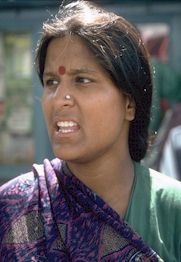 |


|
|
|
|
Compiled by GayToday
Courtesy of the Population Council
 In a study combining demography and anthropology , Finnish sociologist Minna Säävälä has examined the popularity of female sterilization in rural South India. Her ethnographic case study, published in the December issue of Studies in Family Planning, shows how young mothers can gain prestige by using sterilization to push their influential mothers-in-law symbolically toward old age. By analyzing contraception from a cultural point of view, the author interprets the popularity of sterilization among young women in the area.
In a study combining demography and anthropology , Finnish sociologist Minna Säävälä has examined the popularity of female sterilization in rural South India. Her ethnographic case study, published in the December issue of Studies in Family Planning, shows how young mothers can gain prestige by using sterilization to push their influential mothers-in-law symbolically toward old age. By analyzing contraception from a cultural point of view, the author interprets the popularity of sterilization among young women in the area.
Säävälä's study is based on 14 months of fieldwork in Andhra Pradesh, where fertility is rapidly approaching replacement level, with a total fertility rate of 2.7 children per woman in 1993. Female sterilization is the most commonly used means of contraception in India. In 1992–93, 27 percent of currently married Indian women aged 13–49 years were sterilized. In South India, the proportion of sterilized women is larger than the national average; in Gopalapalli panchaiyat, the local administrative area where the fieldwork was conducted, 44 percent of currently married women younger than age 50 are sterilized, a larger proportion than that of rural Andhra Pradesh. What Gopalapalli women liked about sterilization is that it provides a permanent end to fertility and cannot be reversed, Säävälä found. In order to understand why young women consider these features of sterilization as positive characteristics, Säävälä examined the social relations that affect young wives and explored the cultural notions of the female life cycle.
"When a young woman is sterilized, commonly challenging her mother-in-law's wishes, she humiliates the older woman in other villagers' eyes. The insubordinate daughter-in-law shows that the senior woman's legitimate reign over household matters is dissolving and that she is moving from the prestigious position of respected member of the household toward old age, vulnerability, and social marginality," Säävälä says. The corporeal change that sterilization brings about in the female body is regarded as favorable by young Gopalapalli women. The senior woman, freed from procreation, enjoys the best of female life, having responsibilities toward dependents, being in control of household finances, feeding, and ritual life, and being able to expand her world legitimately into the masculine social sphere. The status and respect enjoyed by senior women in India is overwhelming.
 Sterilized women have, so to speak, split the period of young motherhood into two phases: actively procreative motherhood and post-procreative motherhood. By being sterilized, they have managed to manipulate cultural notions of the female body so as to minimize the ambiguity concerning their reproductive capacity. Thus, young mothers in Gopalapalli are eager to be sterilized, and they regard such a permanent method not only as acceptable but also as desirable when they have given birth to what they consider to be a satisfactory number of children.
Sterilized women have, so to speak, split the period of young motherhood into two phases: actively procreative motherhood and post-procreative motherhood. By being sterilized, they have managed to manipulate cultural notions of the female body so as to minimize the ambiguity concerning their reproductive capacity. Thus, young mothers in Gopalapalli are eager to be sterilized, and they regard such a permanent method not only as acceptable but also as desirable when they have given birth to what they consider to be a satisfactory number of children.
Säävälä notes that the aim of becoming like a senior woman is not greater freedom in the Western sense, but is a goal of gaining new responsibilities, to attain a position of having dependents and, thus, greater prestige. For example, having the opportunity to move about more freely in nonfemale space is valuable because it reflects a woman's prestige and seniority, not because it is valuable in itself. Minna Säävälä is Research Fellow, Department of Sociology/Social Anthropology, Post Office Box 59, SF–00014, University of Helsinki, Finland. Other articles, reports, data, Vol. 30 No. 4, December 1999 Articles: Explanations of Unmet Need for Contraception in Chitwan, Nepal, by Sharon Stash Household Organization, Women's Autonomy, and Contraceptive Behavior in Southern Ethiopia by Dennis P. Hogan, Betemariam Berhanu, and Assefa Hailemariam Reports:Contraceptive Switching in Bangladesh, by Fiona Steele and Ian Diamond Maternal Mortality in Vietnam in 1994-95, by Do Trong Hieu, Robert Hanenberg, Trinh Huu Vach, Dao Quang Vinh, and David Sokal Assessing Recall and Understanding of Informed Consent in a Contraceptive Clinical Trial, by Judith A. Fortney Data: Kyrgyz Republic 1997 DHS; Yemen 1997 DHS. Book Reviews:Charles F. Westoff on Malcolm Potts and Roger Short, Ever Since Adam and Eve: The Evolution of Human Sexuality Charlotte Ellertson and Sarah Thomas on Elsimar M. Coutinho with Sheldon J. Segal, Is Menstruation Obsolete? How Suppressing Menstruation Can Help Women Who Suffer from Anemia, Endometriosis, or PMS |

© 1997-2000 BEI